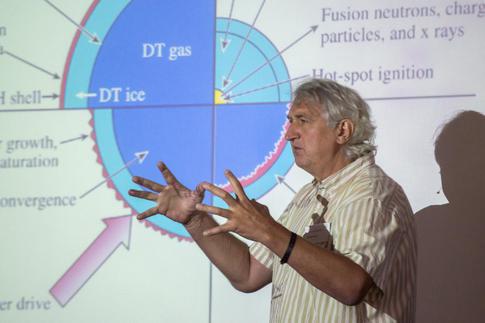XFEL: Tailwind for fusion research
Tailwind for fusion research

Thomas Feurer giving an outlook on how the world's largest X-ray laser can significantly support research in the field of fusion energy. (Photo: European XFEL)
“Our X-ray laser flashes allow us to make ultra-fast processes visible,” says Sakura Pascarelli, Scientific Director of European XFEL. “This enables us to observe exactly how matter behaves as it approaches fusion conditions – a key to answering unresolved questions in fusion research.” Extreme states of matter, which otherwise only occur inside stars or during fusion reactions, can be generated at European XFEL using the extremely powerful lasers of HED-HiBEF[1], one of seven experimental stations at European XFEL.
In particular, European XFEL could help to investigate critical early stages of the fusion reaction. This is done using the facility's extremely short and intense X-ray laser pulses, which make it possible to study the reactions step by step. This would provide extremely detailed images from inside fusion experiments, which can reach down to the atomic level.
“The European XFEL was built to be future-proof,” says Prof. Thomas Feurer, Chairman of the Management Board of European XFEL. "That's why, in addition to our already excellent experimental facilities, we have space in our experimental hall and our photon tunnels to set up a new experimental station specializing in fusion-related research. We are delighted that the Free and Hanseatic City of Hamburg and the state of Schleswig-Holstein intend to provide significant support for this planned expansion." At the new experimental station, the main focus of research will be on “inertial confinement fusion,” laser-based inertial fusion. In this process, spherical fuel capsules are compressed and heated to extremely high temperatures using lasers, causing a fusion reaction to occur.
Overall, research at European XFEL promises answers to a wide range of fusion-related questions. Internationally recognized researchers believe that the results expected from European XFEL in the coming years will significantly advance fusion research.
Position paper of the federal states (PDF, 345 kB, in German)
--
[1] High Energy Density - Helmholtz International Beamline for Extreme Fields
